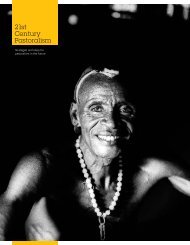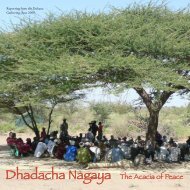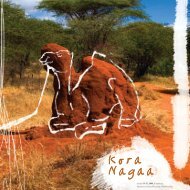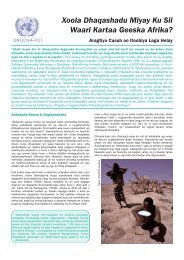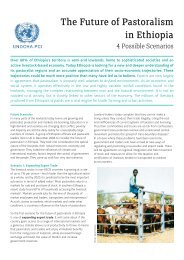Download PDF (1.47Mb) - the Website of the Pastoralist ...
Download PDF (1.47Mb) - the Website of the Pastoralist ...
Download PDF (1.47Mb) - the Website of the Pastoralist ...
You also want an ePaper? Increase the reach of your titles
YUMPU automatically turns print PDFs into web optimized ePapers that Google loves.
ABOUT<br />
THE KARAMOJA<br />
RESEARCH<br />
5. Planning <strong>the</strong> research<br />
People and Places<br />
The plan focuses on people and places. The first stage is to agree on <strong>the</strong> limits. How wide an area? How many<br />
locations? How many people? How much time? When conducting <strong>the</strong> research, and when explaining and<br />
justifying it to o<strong>the</strong>rs, it helps to be clear about from where and whom <strong>the</strong> findings came – we went to <strong>the</strong>se<br />
areas, we talked to <strong>the</strong>se people.<br />
To agree <strong>the</strong> minimum number <strong>of</strong> people and places that are needed to say something true and useful, <strong>the</strong> team<br />
works out <strong>the</strong> diversity <strong>of</strong> people and places according to <strong>the</strong> parameters <strong>of</strong> <strong>the</strong> research questions, e.g. <strong>the</strong><br />
range <strong>of</strong> livelihoods, and <strong>the</strong> range <strong>of</strong> different players in society affecting young people’s choices. How many<br />
people and places will be enough to get a set <strong>of</strong> perspectives that is sufficiently broad and deep?<br />
To agree <strong>the</strong> maximum number <strong>of</strong> people and places for <strong>the</strong> research plan, <strong>the</strong> team takes account <strong>of</strong> pragmatic<br />
considerations. How many people and places will be manageable within <strong>the</strong> time, people and resources that<br />
we have?<br />
In Napak and Moroto Districts, <strong>the</strong> research team needed to make sure that <strong>the</strong>y visited places that would<br />
show all <strong>the</strong> main livelihoods. They were familiar with <strong>the</strong> area and made a map on which <strong>the</strong>y marked all<br />
<strong>the</strong> livelihoods <strong>the</strong>y knew <strong>of</strong> in each location. They selected 6 sub-counties and 16 settlements across <strong>the</strong> subcounties.<br />
In places where a research team is less familiar with <strong>the</strong> pr<strong>of</strong>ile <strong>of</strong> <strong>the</strong> area, it might find that it needs<br />
to begin by collecting basic information from reliable sources. Then it might plan an initial set <strong>of</strong> places to visit,<br />
adding additional places as it learns.<br />
In choosing how many people to speak to, <strong>the</strong> team knew that it needed to engage enough people doing each<br />
livelihood, and enough people <strong>of</strong> different ages, ethnicities and places to begin to see patterns and tendencies.<br />
The team decided to cover at least 6 different areas to account for <strong>the</strong> differences in livelihoods.<br />
They worked out that <strong>the</strong>re was time to spend one day in each place. The 12 people 1 , working in pairs, would<br />
be able to manage about 4 interviews per pair or a total <strong>of</strong> 24 per place, giving an overall total <strong>of</strong> around 384<br />
interviews.<br />
“We made a map <strong>of</strong> <strong>the</strong> two districts and selected four sub-counties that show<br />
<strong>the</strong> livelihoods. Later we added two more sub-counties to include mining and<br />
quarrying, and traditional herding. We wrote <strong>the</strong> names <strong>of</strong> all <strong>the</strong> parishes and<br />
picked 16 at random from one <strong>of</strong> our hats. We planned our routes, and worked out<br />
security, logistics, timing and communication by cellphone. We prepared letters<br />
<strong>of</strong> introduction. We appointed guardians <strong>of</strong> <strong>the</strong> purpose, community respect,<br />
logistics, analysis, photography and security.”<br />
1<br />
The 13th team member, Joyce, was going to be away at her university<br />
graduation during <strong>the</strong> first week <strong>of</strong> visits to <strong>the</strong> communities, and would rejoin<br />
<strong>the</strong> team half way through.<br />
- 11 -



